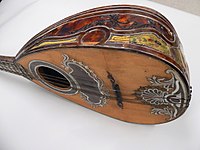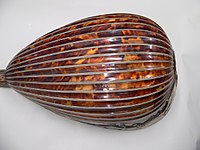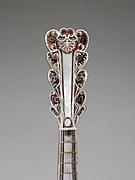Pasquale Vinaccia
Pasquale Vinaccia | |
|---|---|
 Pasquale Vinaccia, luthier and creator of the Neapolitan Mandolin. | |
| Born | 20 July 1806 Italy |
| Died | c. 1882 Italy |
| Occupation | Luthier |
| Known for | creating the "Neapolitan Mandolin" |
Pasquale Vinaccia (1806—c. 1882) was an Italian luthier, appointed instrument-maker for the Queen of Italy, and maternal grandfather to Carlo Munier.[1][2][3] In 1835 he improved the mandolin, creating a version of the instrument that used steel wires for strings, known today as the "Neapolitan Mandolin."[3][4][2] His use of steel strings has become the dominant way of stringing mandolins.
Developing the mandolin
The first evidence of modern metal-string mandolins is from literature regarding popular Italian players who travelled through Europe teaching and giving concerts. Notable are Gabriele Leone, Giovanni Battista Gervasio, Pietro Denis, who travelled widely between 1750 and 1810.[5][6] This, with the records gleaned from the Italian Vinaccia family of luthiers in Naples, Italy, led some musicologists to believe that the modern steel-string mandolins were developed in Naples by the Vinaccia family. Pasquale was born into this musical instrument making family and was the son of Gaetano Vinaccia.[2]
Not limited to mandolins, the Vinaccias made stringed instruments, including violins, cellos, guitars, mandolas and mandolins. Noted members of the family who made mandolins are known today from labels inside of surviving instruments and include Vincenzo, Giovanni, Domenico, and Antonio (and his sons Gaetano and Gennaro, grandson Pasquale and great-grandsons Gennaro and Achille). The mandolins they made changed over generations, from mandolinos with flat soundboards and gut-strings, through mandolins with a bent soundboard and bronze or bronze-and-gut strings, into mandolins with bent soundboards that used steel or steel-and-bronze strings.
Pasquale modernized the mandolin by raising and extending the fingerboard to 17 frets and introducing the stronger wire strings made of high-tension steel.[4][3] He substituted a machine head for the friction tuning pegs that were standard in the early 19th Century.[4][3] The new wire strings required that he strengthen the mandolin's body, and he deepened the mandolin's bowl, giving the tonal quality more resonance.[4]
His own sons, Gennaro and Achille, were also luthiers.[2] Instruments were made into the 1880s bearing the label Pasquale Vinaccia and sons. He had two daughters Teresa and Rosa. Rosa was the mother of mandolinist virtuoso Carlo Munier.[7]
Elder family and cousins
There is confusion currently as to the name of the eldest Vinaccia luthier. His name has been put forth as Gennaro Vinaccia (c.1710-c.1788) (active c. 1755-c. 1778) and Nic. Vinaccia.[8][9][10]
His son Antonio Vinaccia (1734-1796) was active c. 1756 to c. 1784.[9][11] An early extant example of a mandolin is one built by Antonio Vinaccia in 1759, which resides at the University of Edinburgh.[12] Another is by Giuseppe Vinaccia, built in 1893, is also at the University of Edinburgh.[13] The earliest extant mandolin was built in 1744 by Antonio's son, Gaetano Vinaccia. It resides in the Conservatoire Royal de Musique in Brussels, Belgium.[14]
Gallery
References
- ^
Philip J. Bone (1914). The guitar and mandolin, Biographies of celebrated players and composers for these instruments. London: Schott and Company. pp. 220–221.
Pasquale Vinaccia of Naples, the perfector of the modern Italian mandolin. The name of Vinaccia is emblazoned amongst the most exhalted of the world's stringed instrument makers, and it was the inventive genius of this member of the family — born July 20, 1806 in Naples, and died there in 1882 — that gave the instrument its steel strings and consequent machine head, who extended the compass of its fingerboard and enlarged and improved the tonal capabilities and qualities of the instrument.
- ^ a b c d "Information on Pasquale Vinaccia, violin maker in Naples, Italy". amati.com. Archived from the original on 27 June 2015. Retrieved 26 June 2015.
- ^ a b c d "The Bickford mandolin method". Retrieved 21 December 2014.
For the perfected form of the Neapolitan mandolin we are indebted entirely to the inventive genius of Pasquale Vinaccia (1806-1882), who gave us every point of difference between the antique and the modern forms. It was he who remodeled and extended the fingerboard; introduced wire strings and substituted the machine head.
- ^ a b c d Sparks, Paul (1995). The Classical Mandolin. Oxford: Clarendon Press. pp. 115–117. ISBN 978-0-19-517337-6.
- ^ The New Grove Dictionary of Music and Musicians, Second Edition, edited by Stanley Sadie and others (2001)
- ^ Sparks 2003, p. 218
- ^ Stefano (11 December 2008). "Carlo Munier". mandolincafe.org. Retrieved 22 May 2017.
...Carlo Munier...So I have discovered the link wilth Vinaccia family, a very simple link, indeed his mother is Rosa Vinaccia as stated on his birth certificate.
- ^ Fedele, Carlo (29 June 2015). "Il Mandolino Napoletano". linkabile.it. Retrieved 7 October 2016.
I membri più importanti della famiglia Vinaccia sono Gennaro (attivo tra il 1755 e il 1784) e i suoi figli Antonio, Vincenzo(attivo tra il 1767 e il 1802) e Giovanni (attivo tra il 1767 e il 1777). Da Gaetano Vinaccia (attivo tra il 1779 e il 1821), figlio di Antonio, discende Pasquale (1806–85), che costruì i primi mandolini montati con corde d'acciaio e meccaniche. [Translation to English]: The most important members of the family are Gennaro Vinaccia (active between 1755 and 1784) and his children Antonio, Vincenzo (active between 1767 and 1802) and John (active between 1767 and 1777). By Gaetano Vinaccia (Active between 1779 and 1821), Antonio's son, Pasquale descends (1806–85), who built the first mandolins fitted with steel strings as well.
- ^ a b "Biography of Antonio Vinaccia". Amati.com. Retrieved 27 March 2015.
- ^ "vinaccia". Retrieved 28 May 2017.
Vincenzo Gennaro 1710 - 1788
- ^ "Biography of Gennaro Vinaccia". Amati.com. Retrieved 27 March 2015.
- ^ "Neapolitan mandolin". Retrieved 26 March 2015.
- ^ "Neapolitan mandolin". Retrieved 25 March 2015.
- ^ Tyler & Sparks 1989
External links
- Page with guitar and mandolin made by Pasquale Vinaccia for Queen Margherita of Italy
- Bio of Carlo Munier from Etude magazine, January 1941. Talks about Munier's relationship with Vinaccia family.
Sources
- Sparks, Paul (2003). The Classical Mandolin. Oxford: Oxford University Press. ISBN 9780195173376.
- Tyler, James; Sparks, Paul (1989). The early mandolin. Clarendon Press. ISBN 9780193185166.






